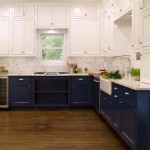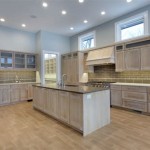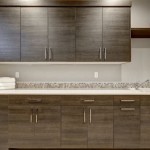What Color Is Good For Kitchen Walls?
Choosing the right color for kitchen walls can significantly impact the room's overall aesthetic and atmosphere. Several factors influence color selection, including the kitchen's size, lighting, existing décor, and desired mood. This article explores various color options and their effects on the kitchen environment.
White and Off-White: White remains a popular choice for kitchen walls due to its timeless appeal and ability to create a sense of cleanliness and spaciousness. It reflects light effectively, making smaller kitchens appear larger. Off-white shades, such as ivory or cream, offer a warmer alternative while maintaining a bright and airy feel. These neutral backdrops provide versatility, allowing for flexibility in incorporating various accent colors and design styles.
Gray: Gray has emerged as a versatile and sophisticated color option for kitchen walls. From light and airy dove gray to deeper charcoal tones, gray offers a wide range of options to suit different styles. Lighter grays create a calming and contemporary atmosphere, while darker shades add drama and depth. Gray pairs well with various cabinet colors, including white, black, and wood tones.
Beige and Greige: Beige provides a warm and inviting atmosphere, creating a sense of comfort and familiarity. It works well in traditional and transitional kitchen designs. Greige, a blend of gray and beige, offers a more contemporary neutral option that retains the warmth of beige while incorporating the sophistication of gray. Both colors provide a versatile backdrop for various accent colors and textures.
Blue: Blue evokes a sense of tranquility and calmness, making it a popular choice for kitchens. Lighter blues, such as sky blue or pale aqua, create a fresh and airy atmosphere, while deeper navy blues add a touch of elegance and sophistication. Blue pairs well with white cabinets and countertops, creating a crisp and clean look. Consider incorporating natural wood elements to balance the coolness of blue.
Green: Green brings a touch of nature indoors, creating a refreshing and revitalizing kitchen environment. Light greens, such as mint or sage, offer a calming and airy feel, while deeper emerald or forest greens create a more dramatic and sophisticated look. Green complements natural wood tones and pairs well with white or cream accents.
Yellow: Yellow is a cheerful and energetic color that can brighten up any kitchen. Pale yellows create a sunny and welcoming atmosphere, while bolder shades add a touch of vibrancy and personality. Yellow works well in kitchens with ample natural light and can be paired with white, gray, or wood tones.
Black: Black can create a dramatic and sophisticated look in the kitchen, particularly when used in kitchens with ample lighting. It adds depth and contrast, making a bold statement. Black pairs well with stainless steel appliances and light-colored countertops, creating a sleek and modern aesthetic. It can also be used as an accent color on kitchen islands or lower cabinets.
Two-Tone Walls: Utilizing two different colors on kitchen walls can create visual interest and define specific areas within the space. A common approach is to use a darker shade on the lower portion of the walls and a lighter shade above, creating a grounding effect. Alternatively, one wall can be painted a different color to serve as a focal point or to visually separate the kitchen from an adjacent dining area.
Considering Lighting: Natural and artificial lighting significantly impact how wall colors appear in a kitchen. North-facing kitchens typically receive less natural light, so lighter colors are recommended to brighten the space. South-facing kitchens receive ample natural light, allowing for more flexibility in color choices. Test paint samples on the walls under different lighting conditions to ensure the desired effect is achieved.
Cabinet and Countertop Coordination: The color of kitchen cabinets and countertops plays a crucial role in selecting wall colors. Consider the existing or planned cabinetry and countertop colors to ensure a harmonious overall look. Contrasting colors can create a dynamic and visually appealing space, while complementary colors create a more cohesive and unified feel.
Personal Preferences and Style: Ultimately, the best color for kitchen walls depends on personal preferences and the overall design style of the home. Consider the desired mood and atmosphere for the kitchen. Do you prefer a calming and serene space or a vibrant and energetic environment? Choose colors that reflect personal style and create a space that feels welcoming and comfortable.
Testing Paint Samples: Before committing to a specific color, it's essential to test paint samples on the kitchen walls. Paint a small section of each wall with the chosen colors and observe them under different lighting conditions throughout the day. This allows for a realistic assessment of how the colors will appear in the space and helps ensure a satisfying final result.

40 Best Kitchen Paint And Wall Colors For 2024

Dulux Kitchen Paint Colours

8 Kitchen Wall Paint Colours For Your Home Designcafe

The Top 10 Most Popular Kitchen Colours Of 2024

8 Kitchen Wall Paint Colours For Your Home Designcafe

Dulux Kitchen Paint Colours

The Best Wall Colors For Kitchens Pictures Paint Color Ideas Love Remodeled

70 Top Kitchen Paint Colors Best 2024

Get Creative With These Paint Colors For Your Small Kitchen Asian Paints

8 Kitchen Wall Paint Colours For Your Home Designcafe
Related Posts








